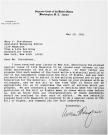How Much Judicial Politicization is There?
The “attitudinal model” in political science posits that judges, and particularly Supreme Court justices, implement their policy preferences in their judicial decisions. Devotees of the attitudinal model in political science nail down one (popular) extreme of the discipline. While many political scientists in “public law” discuss law-related subjects akin to how they are taught in law schools, many political scientists in the cognate field of “judicial behavior” believe the evidence suggests policy preferences motivate judges at least to some extent. The open question in the subfield is the extent to which political preferences influence decisions.
Political scientists do not commend political judging, they seek to describe what “is” rather than what ought to be. In this they share the opinion of some of the Constitution’s framers. As I discussed last week, Alexander Hamilton recognized judges would implement their policy preferences in their judicial decisions at least some of the time. Nonetheless, Hamilton suggested in Federalist 81 the problem would never rise to the level of an “inconvenience” affecting “in any sensible degree . . . the order of the political system” because the power of impeachment “alone” would provide “a complete security” against serious judicial usurpations of legislative prerogative. The absence of judicial impeachments based on policy disagreements since the Chase impeachment in 1803 opens the question whether Hamilton’s “complete security” evolved into the dog that would not bark. (On the other hand, one could argue the mere threat of impeachment worked so well that serious political activity from the bench, as Chase indulged in, have been successfully deterred.)
As I mentioned, nailing down one extreme on the question in political science regarding the extent to which judges implement policy preferences in their decisions are the “attitudinalists.” The most visible attitudinalists are Jeffrey A. Segal and (the late) Harold J. Spaeth. Developing measures of political preferences of Supreme Court justices, and measures of case facts in search and seizure cases, Segal and Spaeth argued from their data and statistical work in their 2002 book, The Supreme Court and the Attitudinal Model Revisited, that political opinions of Supreme Court justices accounted for 70 percent of the decisions in those cases.
It is, to say the least, a bracing claim. While we can quibble with the data and the measures, nonetheless, for the most part, political scientists in judicial politics concede the results by Segal and Spaeth (and others) are persuasive enough credibly to establish that judicial policy preferences, at least at the level of the U.S. Supreme Court, affect judicial outcomes some of the time. To be sure, Alexander Hamilton suggested as much over 200 years ago in Federalist 81.
The question is whether the level of politicization is as extensive as Segal and Spaeth (and others) suggest from the evidence they provide.
It’s possible, but I’m doubtful.
First, what attitudinalist empirical results provide is an association between political beliefs of Supreme Court justices (more accurately, measures of political attitudes) and legal outcomes those justices support. The claim that the former causes the latter is surmise. But what else might be happening if the justices’ political beliefs don’t cause their decisions?
Every judge and justice I’ve heard opine about the influence of his or her political opinions on his or her judicial decisions denies any influence at all. They claim to apply the law as they understand it. While they could be fibbing, or could be lacking in self-awareness, I actually believe them for the most part. But I also believe the data show us associations between political ideology and judicial decisions.
What gives?
Here’s the trick. There is a coherent legal theory that generates legal decisions applauded by just about any mainstream political ideology out there. By “coherent” I don’t mean each of competing legal theories is true and correct, I mean there are internally consistent applications of law and legal reasoning that, for the most part, generate legal outcomes – winners and losers – approved by just about every mainstream (and some not so mainstream) political opinion out there. This means it is possible for judges to be firmly law-based in their reasoning in a case, yet for decisions consistently to map empirically onto outcomes legislators consistently approve (or disapprove).
Politicians tend to select individuals for appointment and confirmation whose legal philosophies serve the political ends those politicians want to achieve. The judicial candidates themselves can hold legally doctrinaire positions about law and legal reasoning. But they are selected by politicians because those doctrinaire positions map onto substantive political outcomes the selecting politicians want to achieve. Political motivation is located in the political branches, however, not in the political motivation of the judges. Judges can honestly report they apply legal precepts in their decisions rather than their political philosophy. If correct, we would be able to grant the statistical associations reported by attitudinalists (and others) but we could resist the conclusion that judges base their decisions on their policy preferences.
The same rationale can apply to judges themselves. Most of us, I would guess, seek out and adopt legal philosophies pretty much consistent with the social and political values we hold dear. (To be sure, there can be process commitments as well that do not map directly onto substantive policy positions. I plan to discuss that possibility later this week.) But to say judges hold legal theories pretty much consistent with the social and political values they hold dear is not to say those legal theories do not have their own integrity as internally coherent legal theories. They do. Therefore judges can report their decisions simply apply the legal philosophies they hold. (Or we can tweak this claim: Some judges all the time, all judges some of the time . . .)
Beyond that, attitudinalist empirical results contain aspects that should worry hard attitudinalists who want to argue all judicial decisions are political. Even in Segal and Spaeth’s book, almost one out of three “search and seizure” outcomes did not map onto the respective justice’s political ideology. To be sure, that could represent difficulties in accurately measuring the ideologies of judges, but it could also reflect other considerations at work in judicial decisions, such as legal reasoning that leads justices to decisions inconsistent with their political opinions. There is, after all, variation in the statistical associations for different policy areas and different eras.
This unexplained variation, combined with some association between distinct, albeit coherent, legal theories and substantive policy outcomes as an alternative theory for the explained variation attitudinalists point to, suggests reasons to doubt theoretical strength of hard attitudinalism.

